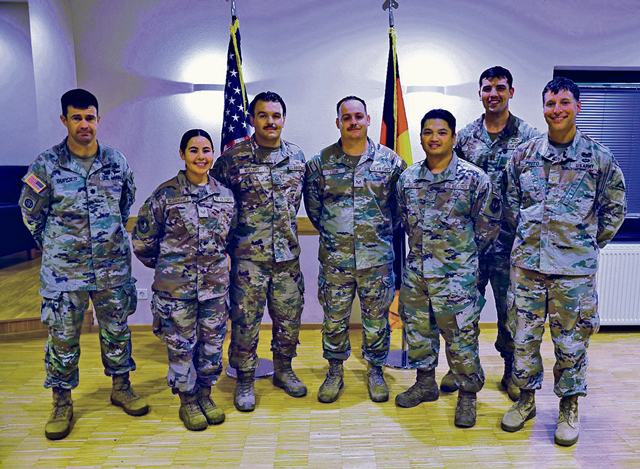
In a demonstration of joint force cooperation, members of the U.S. Army and Air Force worked together to rehabilitate a dirt landing zone at Hohenfels Training Area, just in time for NATO’s Saber Junction 2024 exercise. The airstrip was restored through the combined efforts of the U.S. Army’s Raptor Engineer Team at the Joint Multinational Readiness Center, Hohenfels, the U.S. Air Force’s 435th Construction Training Squadron, and various Reserve and National Guard units.
A strategic need
The Hohenfels LZ had been non-operational for several years, unable to meet the demanding requirements for C-130J Super Hercules aircraft landings due to improper maintenance and environmental wear. With Saber Junction 2024 on the horizon, a large-scale NATO exercise involving complex airborne operations and airfield seizures, the need to restore the LZ became urgent.
“The airstrip had been out of commission for four to five years, and the Army reached out to us because they knew the importance of having this LZ operational for their upcoming exercises,” said U.S. Air Force Master Sgt. Jeremiah Wilkens, 435th CTS superintendent of military construction. “Originally, we estimated it would take three to six months to bring the LZ up to spec, but thanks to a tremendous team effort, we got it done in just over a month.”
The challenge of time
U.S. Army Maj. Charles Pinto, project manager and officer in charge of the troop construction program at JMRC, was the driving force behind the operation. Pinto’s use of the Trans-Atlantic Castle program, which brings U.S. Army Reserve and National Guard engineer units from the continental United States to Germany for various construction projects, was a factor in the successful completion of the LZ restoration.

The restoration required coordination, manpower and specialized equipment. The Army did not have all the required expertise on hand, leading them to seek assistance from the Air Force, specifically the 435th CTS.
“Major Pinto was the one who brought this entire project together,” said U.S. Army Lt. Col. Jeff Burges, brigade engineer battalion senior trainer at JMRC. “He resourced and organized funds for materials, contracted equipment, coordinated transportation, and arranged TDYs for personnel from across Europe and CONUS. He oversaw three rotations of Trans-Atlantic Castle, which allowed Army engineers to do the bulk of the construction work, while Air Force personnel provided the necessary expertise to ensure the LZ met all required standards.”
Technical expertise and coordination
The 435th CTS provided critical technical assistance, which included surveying the landing zone and ensuring that the soil compaction met the required standards for aircraft landings. They were also responsible for the overall project management, including surveying the LZ and ensuring that the compaction of the soil met the necessary standards for aircraft landings. U.S. Air Force Staff Sgt. Karissa Rodriguez, an engineering technician with the 435th CTS, played a pivotal role as the project manager.
“The construction of the LZ required the soil to reach the ideal shear strength and compaction, as well as meet Unified Facilities Criteria specification critical for safe landings,” Rodriguez said. “We used a combination of surveyors and equipment operators to achieve the necessary slopes and compaction, and then certified the airstrip to ensure the LZ meets the appropriate operational and safety standards for C-130 landings.”
Joint effort and overcoming challenges
According to Pinto, one of the significant hurdles faced by the team was the procurement of necessary materials and equipment.
“We had to bring in gravel and other materials from various locations, and equipment was borrowed from multiple units, including a GPS grader from the 15th Engineer Battalion in Grafenwoehr,” Pinto said. “Coordination was key. We were borrowing and contracting equipment from all over Europe and the U.S., but it all came together.”
The final phase of the project involved quality assurance and control, with additional support from the 820th RED HORSE Squadron from Nellis Air Force Base, Nevada, and New Hampshire Air National Guard. Their role was to ensure the airstrip met all safety and operational standards.
The strategic importance of the LZ
Burges emphasized that the successful completion of the Hohenfels LZ has far-reaching implications beyond the immediate exercise, including its strategic importance for NATO operations in Europe.
“This isn’t just about one exercise; this airfield provides a critical strategic platform in Europe, supporting both training and real-world operations,” Burges said. “It enhances our capability to conduct airborne operations and improves our overall readiness.”
Burges further elaborated on the importance of having a functional LZ from an Army perspective.
“When an airborne brigade conducts an airborne operation, they have limited combat power at the moment they hit the ground. They need some means to quickly increase their available combat power, and an airfield is a great example. Army paratroopers train for airfield seizure because they need some way to quickly increase combat power once on the ground,” Burges said. “The LZ allows for rapid air land operations, bringing in additional combat power to support the mission.”
Recognition of efforts
In a ceremony held at Ramstein Air Base, four Air Force personnel were recognized with Army awards for their contributions. U.S. Air Force Staff Sgt. Jesse Mallory, a heavy equipment and pavements specialist with the 435th CTS, was one of the recipients.
“We helped establish a baseline for what was necessary to reconstruct the LZ and also got some valuable training in for the reservists,” Mallory said. “It was a great experience.”
Other U.S. Air Force awardees included Staff Sgt. Alex Look, who provided critical equipment training to Army personnel, and Tech. Sgt. Johnneil “chess master” Rojas, who led the surveying team that laid the groundwork for the entire project.
Staff Sgt. Karissa Rodriguez’s efforts were recognized with an Army Commendation Medal, presented by Burges during a ceremony held at Ramstein AB.
“Staff Sergeant Rodriguez gave up her summer to be out here, working from sunup to sundown every day,” Burges said. “Without her expertise, this project wouldn’t have been completed on time.”
The future of Joint Operations
The successful collaboration between the U.S. Army and Air Force at Hohenfels is a testament to the power of joint operations. It not only highlights the ability of U.S. forces to work together under pressure but also underscores the importance of cross-service training and cooperation.
“This project shows that you don’t have to wait for leadership to mandate collaboration,” said U.S. Air Force Capt. Ross Jurek, 435th CTS MCF flight commander. “The Army is a ready and willing partner. If you reach out, there are always opportunities to work together and learn from each other.”
As Saber Junction 2024 kicks off, the revitalized Hohenfels LZ will stand as a symbol of what can be achieved when the U.S. Army and U.S. Air Force combine their strengths. It also sets a precedent for future joint efforts, demonstrating that with the right people and resources, even the most challenging projects can be completed ahead of schedule and to the highest standards.
Looking ahead
With the success of the Hohenfels project, the 435th CTS and their Army counterparts are already looking ahead to future collaborations. The lessons learned from this project will inform how both services approach similar challenges in the future, ensuring that U.S. and NATO forces remain ready to respond to any contingency, anywhere in the world. The teams involved can take pride in a job well done and the continued strategic readiness of U.S. and NATO forces in Europe.


